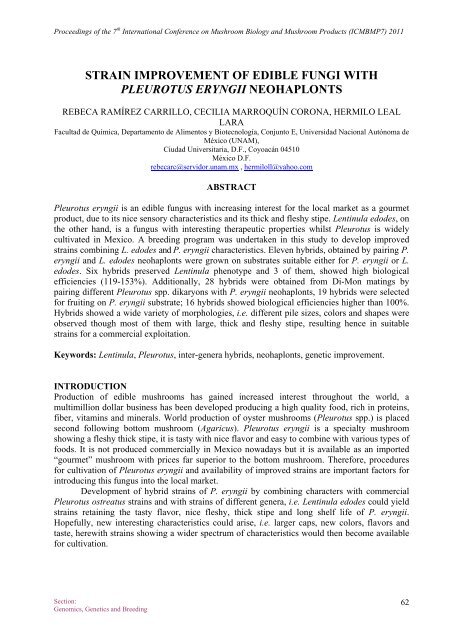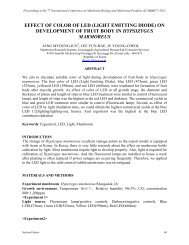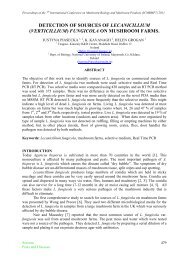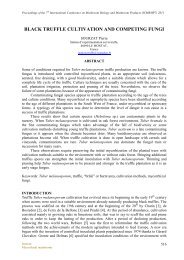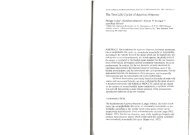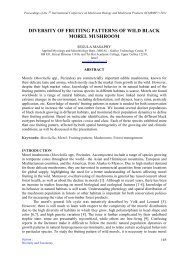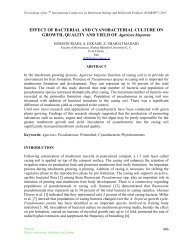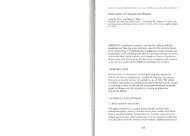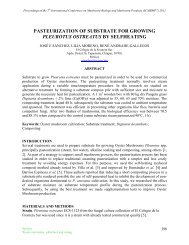Strain improvement of edible fungi with Pleurotus eryngii ...
Strain improvement of edible fungi with Pleurotus eryngii ...
Strain improvement of edible fungi with Pleurotus eryngii ...
You also want an ePaper? Increase the reach of your titles
YUMPU automatically turns print PDFs into web optimized ePapers that Google loves.
Proceedings <strong>of</strong> the 7 th International Conference on Mushroom Biology and Mushroom Products (ICMBMP7) 2011<br />
STRAIN IMPROVEMENT OF EDIBLE FUNGI WITH<br />
PLEUROTUS ERYNGII NEOHAPLONTS<br />
REBECA RAMÍREZ CARRILLO, CECILIA MARROQUÍN CORONA, HERMILO LEAL<br />
LARA<br />
Facultad de Química, Departamento de Alimentos y Biotecnología, Conjunto E, Universidad Nacional Autónoma de<br />
México (UNAM),<br />
Ciudad Universitaria, D.F., Coyoacán 04510<br />
México D.F.<br />
rebecarc@servidor.unam.mx , hermiloll@yahoo.com<br />
ABSTRACT<br />
<strong>Pleurotus</strong> <strong>eryngii</strong> is an <strong>edible</strong> fungus <strong>with</strong> increasing interest for the local market as a gourmet<br />
product, due to its nice sensory characteristics and its thick and fleshy stipe. Lentinula edodes, on<br />
the other hand, is a fungus <strong>with</strong> interesting therapeutic properties whilst <strong>Pleurotus</strong> is widely<br />
cultivated in Mexico. A breeding program was undertaken in this study to develop improved<br />
strains combining L. edodes and P. <strong>eryngii</strong> characteristics. Eleven hybrids, obtained by pairing P.<br />
<strong>eryngii</strong> and L. edodes neohaplonts were grown on substrates suitable either for P. <strong>eryngii</strong> or L.<br />
edodes. Six hybrids preserved Lentinula phenotype and 3 <strong>of</strong> them, showed high biological<br />
efficiencies (119-153%). Additionally, 28 hybrids were obtained from Di-Mon matings by<br />
pairing different <strong>Pleurotus</strong> spp. dikaryons <strong>with</strong> P. <strong>eryngii</strong> neohaplonts, 19 hybrids were selected<br />
for fruiting on P. <strong>eryngii</strong> substrate; 16 hybrids showed biological efficiencies higher than 100%.<br />
Hybrids showed a wide variety <strong>of</strong> morphologies, i.e. different pile sizes, colors and shapes were<br />
observed though most <strong>of</strong> them <strong>with</strong> large, thick and fleshy stipe, resulting hence in suitable<br />
strains for a commercial exploitation.<br />
Keywords: Lentinula, <strong>Pleurotus</strong>, inter-genera hybrids, neohaplonts, genetic <strong>improvement</strong>.<br />
INTRODUCTION<br />
Production <strong>of</strong> <strong>edible</strong> mushrooms has gained increased interest throughout the world, a<br />
multimillion dollar business has been developed producing a high quality food, rich in proteins,<br />
fiber, vitamins and minerals. World production <strong>of</strong> oyster mushrooms (<strong>Pleurotus</strong> spp.) is placed<br />
second following bottom mushroom (Agaricus). <strong>Pleurotus</strong> <strong>eryngii</strong> is a specialty mushroom<br />
showing a fleshy thick stipe, it is tasty <strong>with</strong> nice flavor and easy to combine <strong>with</strong> various types <strong>of</strong><br />
foods. It is not produced commercially in Mexico nowadays but it is available as an imported<br />
“gourmet” mushroom <strong>with</strong> prices far superior to the bottom mushroom. Therefore, procedures<br />
for cultivation <strong>of</strong> <strong>Pleurotus</strong> <strong>eryngii</strong> and availability <strong>of</strong> improved strains are important factors for<br />
introducing this fungus into the local market.<br />
Development <strong>of</strong> hybrid strains <strong>of</strong> P. <strong>eryngii</strong> by combining characters <strong>with</strong> commercial<br />
<strong>Pleurotus</strong> ostreatus strains and <strong>with</strong> strains <strong>of</strong> different genera, i.e. Lentinula edodes could yield<br />
strains retaining the tasty flavor, nice fleshy, thick stipe and long shelf life <strong>of</strong> P. <strong>eryngii</strong>.<br />
Hopefully, new interesting characteristics could arise, i.e. larger caps, new colors, flavors and<br />
taste, here<strong>with</strong> strains showing a wider spectrum <strong>of</strong> characteristics would then become available<br />
for cultivation.<br />
Section:<br />
Genomics, Genetics and Breeding<br />
62
Proceedings <strong>of</strong> the 7 th International Conference on Mushroom Biology and Mushroom Products (ICMBMP7) 2011<br />
MATERIALS AND METHODS<br />
<strong>Strain</strong>s. Following strains were used for production <strong>of</strong> hybrids by mating neohaplonts and<br />
dikaryotic strains: A commercial P. <strong>eryngii</strong> dikaryon [1], 11 neohaplonts (designated from PeC9<br />
to PeC45) recovered by dedikaryotization from the commercial P. <strong>eryngii</strong> dikaryon [2], 4 L.<br />
edodes dikaryons (L9, L10, L18, L21) [3], a dikaryotic <strong>Pleurotus</strong> djamor strain [4], 8 <strong>Pleurotus</strong><br />
spp. dikaryons (Asp14, CP50, CP253, HK3539, IE200, IE201, P401 and <strong>Pleurotus</strong> sp. PB) and 6<br />
neohaplonts (designated from L10-1S to L21-2S) recovered by dedikaryorization <strong>of</strong> L. edodes<br />
strains [2]. All strains are stored in the fungal collection <strong>of</strong> the Department <strong>of</strong> Food Science and<br />
Biotechnology at the Faculty <strong>of</strong> Chemistry (University <strong>of</strong> México). The strains were propagated<br />
in malt extract agar (MEA) (1.5% malt extract and 2% agar); cultures on MEA plates (Petri<br />
dishes) were stored at 2 to 4°C [3].<br />
Hybrids from Matings <strong>of</strong> P. <strong>eryngii</strong> Neohaplonts <strong>with</strong> L. edodes Neohaplonts. Agar cubes (2<br />
mm) full <strong>with</strong> growing mycelia were cut from the edge <strong>of</strong> growing cultures <strong>of</strong> selected P. <strong>eryngii</strong><br />
and L. edodes neohaplonts. They were placed side by side on MEA plates and incubated at 24ºC.<br />
Developing colonies were inspected under the microscope during the following 7 days and those<br />
showing clamp connections were reseeded on MEA plates for further evaluation.<br />
Hybrids from Di-mon Matings <strong>of</strong> P. <strong>eryngii</strong> Neohaplonts <strong>with</strong> <strong>Pleurotus</strong> spp. Dikaryons.<br />
Four agar cubes (2 mm) full <strong>with</strong> growing mycelia were cut from the edge <strong>of</strong> a growing culture<br />
<strong>of</strong> a selected P. <strong>eryngii</strong> neohaplont and symmetrically distributed on the surface <strong>of</strong> a MEA plate<br />
and incubated at 24ºC until development <strong>of</strong> 1 cm (∅) colonies. At this stage, a 2 mm agar cube<br />
was cut from the edge <strong>of</strong> a growing culture <strong>of</strong> a selected dikaryon and placed on the periphery <strong>of</strong><br />
the growing neohaplont culture. Plates were again incubated at 24ºC and inspected under the<br />
microscope every day until appearance <strong>of</strong> clamp connections on the side opposite to the point <strong>of</strong><br />
inoculation <strong>of</strong> the dikaryotic culture. The newly emerging dikaryotic strain (hybrid) was<br />
recovered on MEA plates. Mycelium growth <strong>of</strong> all resulting hybrids as well as <strong>of</strong> their respective<br />
parental dikaryons and neohaplonts was evaluated by placing 8 mm (∅) inocula cut from the<br />
edge <strong>of</strong> a growing culture and placed on MEA, <strong>with</strong> 3 replicates per strain. Colony diameters<br />
were measured after 3, 6 and 9 days incubation and when significant differences were<br />
established by variance analysis, strains were classified according to Duncan test.<br />
Fruiting <strong>of</strong> Hybrid <strong>Strain</strong>s. Two types <strong>of</strong> substrates were used for fruiting <strong>of</strong> hybrids, one is<br />
recommended for fruiting <strong>of</strong> P. <strong>eryngii</strong> and the second one for L. edodes (Table 1).<br />
Table 1: Substrates for fruiting <strong>of</strong> P. <strong>eryngii</strong> and L. edodes hybrids and parental strains<br />
Components<br />
Substrates (% fresh weight)<br />
L. edodes P. <strong>eryngii</strong><br />
Sawdust 50.0 20.0<br />
Cottonseed waste 36.0 60.0<br />
Millet 6.0 -----<br />
Sorghum (milled) 6.0 -----<br />
Wheat bran ----- 16.0<br />
Ammonium sulfate 0.5 -----<br />
Citric acid 0.5 -----<br />
Benlate 1.0 -----<br />
Calcium carbonate ----- 3.0<br />
Calcium sulfate ----- 1.0<br />
Section:<br />
Genomics, Genetics and Breeding<br />
63
Proceedings <strong>of</strong> the 7 th International Conference on Mushroom Biology and Mushroom Products (ICMBMP7) 2011<br />
Both substrates were used for fruiting hybrids <strong>of</strong> P. <strong>eryngii</strong> <strong>with</strong> L. edodes since each<br />
genus requires different substrates for good mycelium growth and fruiting. Hybrids <strong>of</strong> <strong>Pleurotus</strong><br />
<strong>eryngii</strong> neohaplonts <strong>with</strong> <strong>Pleurotus</strong> spp. dikaryons were fruited only on P. <strong>eryngii</strong> substrate.<br />
Sawdust, cottonseed waste and millet were soaked in water for 24 h; after draining excess water,<br />
ingredients were thoroughly mixed according to formulation and water content <strong>of</strong> substrate was<br />
adjusted to 60%. Lentinula substrate (1.5 Kg) was filled into 25 x 35 cm polypropylene bags and<br />
<strong>Pleurotus</strong> substrate (1 Kg) was filled into 17 x 45 cm polypropylene bags. Sterilization and<br />
inoculation <strong>of</strong> substrates as well as preparation <strong>of</strong> spawn was according to Ramírez et al. [3].<br />
After incubation for 9 weeks, Lentinula substrates were transferred into the fruiting room and<br />
polypropylene bags were completely detached in order to expose the whole surface <strong>of</strong> the<br />
substrate to the environment. After incubation for 9 weeks, P. <strong>eryngii</strong> substrates were transferred<br />
to the fruiting room, polypropylene bags were folded down in order to leave only the upper<br />
surface <strong>of</strong> the substrate exposed to the environment. Conditions in the fruiting room throughout<br />
the experiment were 70 to 80% air humidity, 20 to 23°C air temperature and 700 to 900 ppm<br />
CO 2 . Fruit bodies developing on the substrates were harvested before pileus edge turned up<br />
completely. Harvesting period was 12 weeks for P. <strong>eryngii</strong> substrates and 8 weeks for L. edodes<br />
substrates. Weight <strong>of</strong> fresh fruit bodies was registered for each substrate bag and biological<br />
efficiency was determined as BE = g fresh fruit bodies/100 g dry substrate.<br />
Statistical Analysis. Variance analysis <strong>of</strong> biological efficiencies <strong>of</strong> hybrids and parental strains<br />
were performed to evaluate significant differences and Duncan multiple range test was used to<br />
identify the highest producing strains (SPSS ver. 17 for Windows was used for both tests).<br />
RESULTS<br />
Hybrids from Matings <strong>of</strong> P. <strong>eryngii</strong> Neohaplonts <strong>with</strong> L. edodes Neohaplonts. Eleven hybrids<br />
obtained by mating L. edodes and P. <strong>eryngii</strong> neohaplonts were fruited on both types <strong>of</strong> substrates<br />
shown in Table 1 and biological efficiencies <strong>of</strong> the six hybrids presenting L. edodes morphology<br />
are shown in Table 2.<br />
Table 2: Biological efficiencies <strong>of</strong> hybrids <strong>with</strong> L. edodes morphology<br />
Biological efficiency (g fresh fruit bodies / 100 g dry substrate)<br />
<strong>Strain</strong>s<br />
L. edodes substrate P. <strong>eryngii</strong> substrate<br />
Duncan<br />
Duncan<br />
± σ<br />
± σ<br />
test<br />
test<br />
L10 33.82 ± 9.22 A<br />
PeC40 / L18-2S 50.63 ± 16.25 B 44.17 ± 8.04 a<br />
L21 62.51 ± 4.21 BC<br />
L18 67.67 ± 7.53 C<br />
L9 84.13 ± 7.84 D<br />
PeC40 / L18-1S 91.32 ± 12.88 D 55.25 ± 7.06 b<br />
PeC40 / L10-1S 119.44 ± 15.27 E 53.68 ± 3.18 ab<br />
PeC40/ L10-4S2 123.64 ± 6.98 E 61.43 ± 8.45 bc<br />
PeC40 / L10-4S 123.64 ± 6.98 E 53.68 ± 3.18 ab<br />
PeC40/ L21-2S 153.38 ± 9.32 F 68.60 ± 11.88 c<br />
Different letters indicate significant differences in the same substrate<br />
Section:<br />
Genomics, Genetics and Breeding<br />
64
Proceedings <strong>of</strong> the 7 th International Conference on Mushroom Biology and Mushroom Products (ICMBMP7) 2011<br />
All the hybrids produced <strong>with</strong> P. <strong>eryngii</strong> neohaplont PEC40 produced fruit bodies <strong>with</strong><br />
Lentinula morphology whereas hybrids derived from the other 5 neohaplonts belonging to<br />
mating type II paired <strong>with</strong> L. edodes neohaplont L21-3S resulted in fruit bodies <strong>with</strong> P. <strong>eryngii</strong><br />
morphology. Biological efficiencies <strong>of</strong> hybrids producing fruit bodies <strong>with</strong> Lentinula<br />
morphology after 12 weeks <strong>of</strong> cropping period are shown on Table 2. <strong>Strain</strong> PeC40/ L21-2S<br />
produced the highest biological efficiency, 153%, though other 3 hybrids yielded high BE, 119-124%, in<br />
all cases better BE values than control L. edodes strains, whose BE ranged from 34 to 84%. Fig.<br />
1 shows the fruit bodies produced by control P. <strong>eryngii</strong> dikaryon and two L. edodes strains as<br />
well as 4 different hybrids fruiting <strong>with</strong> Lentinula morphology.<br />
Parental <strong>Strain</strong>s<br />
P. <strong>eryngii</strong> L10 L21<br />
Fruit bodies: large. Pileus:<br />
brown grayish <strong>with</strong> regular<br />
edges. Stipe: white colored,<br />
long and thick<br />
Fruit bodies: large. Pileus: dark<br />
brown, thin, slightly convex <strong>with</strong><br />
scales on edges. Stipe: long and thin<br />
Fruit bodies: medium. Pileus: dark<br />
brown, thick, <strong>with</strong>out scales. Stipe:<br />
thin and very short<br />
Hybrid <strong>Strain</strong>s<br />
PeC40/L21-2S PeC40/ L10-4S PeC40/L10-4S2 PeC40/ L10-1S<br />
Fruit bodies: medium,<br />
large and very large.<br />
Pileus: dark brown, thick,<br />
<strong>with</strong> few scales. Stipe:<br />
beige, long and medium<br />
sized, <strong>with</strong> scales<br />
Fruit bodies: medium,<br />
large and very large.<br />
Pileus: dark brown,<br />
thick, <strong>with</strong> abundant<br />
scales. Stipe: beige<br />
<strong>with</strong> brown spots, long<br />
and thick, <strong>with</strong> scales<br />
Fruit bodies: small,<br />
medium and large. Pileus:<br />
light brown, thick, <strong>with</strong><br />
abundant scales. Stipe:<br />
thick medium sized,<br />
whitish <strong>with</strong> scales<br />
Fruit bodies: small,<br />
medium, large and very<br />
large. Pileus: light brown,<br />
thick, <strong>with</strong> few scales.<br />
Stipe: light brown, long<br />
and thin, <strong>with</strong> few scales<br />
Figure 1: Parental strains and highest producing hybrids <strong>with</strong> L. edodes morphologies<br />
Biological efficiencies <strong>of</strong> the 5 hybrids producing fruit bodies <strong>with</strong> P. <strong>eryngii</strong><br />
morphology are shown on Table 3. Hybrids cultivated on P. <strong>eryngii</strong> substrate had lower<br />
Section:<br />
Genomics, Genetics and Breeding<br />
65
Proceedings <strong>of</strong> the 7 th International Conference on Mushroom Biology and Mushroom Products (ICMBMP7) 2011<br />
biological efficiencies (13 to 67%) than the parental P. <strong>eryngii</strong> dikaryon (151%). Noticeably, 2<br />
hybrids, PeC20/L21-3S and PeC29/L21-3S, produced higher yields on P. <strong>eryngii</strong> substrate and<br />
other 2 hybrids, PeC12/L21-3S and PeC45/L21-3S, conversely produced higher BE on L. edodes<br />
substrate, the last hybrid exceeding 100% BE. This suggests that nutrient requirements were<br />
differentially inherited by each group <strong>of</strong> strains, the first one similar to P. <strong>eryngii</strong> and the second<br />
one to L. edodes. The Figure 2 shows the fruit bodies produced by 3 different hybrids fruiting<br />
<strong>with</strong> P. <strong>eryngii</strong> morphology.<br />
Table 3: Biological efficiencies <strong>of</strong> hybrids <strong>with</strong> P. <strong>eryngii</strong> morphology<br />
Biological efficiency (g fresh fruit bodies / 100 g dry substrate)<br />
<strong>Strain</strong>s<br />
P. <strong>eryngii</strong> substrate L. edodes substrate<br />
± σ Duncan test ± σ Duncan test<br />
PeC20/L21-3S 43.61 ± 7.02 B 14.12 ± 1.94 a<br />
PeC29/L21-3S 61.25 ± 8.63 CD 21.42 ± 5.94 ab<br />
PeC12/L21-3S 13.16 ± 1.91 A 33.47 ± 3.61 b<br />
PeC27/L21-3S 67.44 ± 10.96 D 56.38 ± 8.27 c<br />
PeC45/L21-3S 56.13 ± 6.00 C 111.79 ± 17.55 d<br />
P. <strong>eryngii</strong> 151.42 ± 11.49 E<br />
Different letters indicate significant differences in the same substrate.<br />
PeC45/ L21-3S PeC27/L21-3S PeC12/L21-3S<br />
Fruit bodies: large and very<br />
large. Pileus: light brown,<br />
thick, <strong>with</strong> undulated edges.<br />
Stipe: white, long and thick<br />
Fruit bodies: small and medium.<br />
Pileus: white, <strong>with</strong> undulated<br />
edges. Stipe: white, medium, thin<br />
to thick<br />
Fruit bodies: small, medium and<br />
large. Pileus: light brown, <strong>with</strong><br />
regular edges. Stipe: white,<br />
medium, thin to thick<br />
Figure 2: Hybrids between P. <strong>eryngii</strong> and L. edodes <strong>with</strong> P. <strong>eryngii</strong> morphologies on L.<br />
edodes substrate<br />
Hybrids from Di-mon Matings <strong>of</strong> P. <strong>eryngii</strong> Neohaplonts <strong>with</strong> <strong>Pleurotus</strong> spp. Dikaryons.<br />
Mycelium growth rate <strong>of</strong> the 28 hybrids obtained by this procedure was measured to identify<br />
those showing similar growth to the parental strains, and those showing either faster or slower<br />
growth than the parental strains. For fruiting experiments, the following 19 hybrids were selected<br />
from these 3 groups:<br />
hybrids <strong>with</strong> faster mycelium growth than parental strains:<br />
PeC9/CP50 PeC20 / IE200 PeC38 / P401<br />
Section:<br />
Genomics, Genetics and Breeding<br />
66
Proceedings <strong>of</strong> the 7 th International Conference on Mushroom Biology and Mushroom Products (ICMBMP7) 2011<br />
PeC12 / P401 PeC35 / P. djamor PeC38 / ASP14<br />
PeC12 / P. djamor PeC35 / HK3539 PeC44 / P. djamor<br />
PeC20 / P. djamor PeC38 / P. djamor PeC44 / P401<br />
hybrids <strong>with</strong> similar mycelium growth than parental strains<br />
PeC11 /CP50 PeC35 /P401<br />
PeC35/ <strong>Pleurotus</strong> sp. PB PeC44 / CP253<br />
hybrids <strong>with</strong> slower mycelium growth than parental strains<br />
PeC12 / CP253 PeC20 / ASP14 PeC20 / IE201<br />
Biological efficiencies <strong>of</strong> the 19 hybrids produced by di-mon matings are shown in Table<br />
4. <strong>Strain</strong> PeC11/CP50 showed up as the highest producing hybrid <strong>with</strong> an amazing 323%<br />
biological efficiency, however, 3 other hybrids produced also very high yields, i.e. PeC9/CP50<br />
(271%), PeC12/P401 (207%) and PeC35/<strong>Pleurotus</strong> sp. PB (177%), in all cases, BE were<br />
significantly higher than BE <strong>of</strong> the parental P. <strong>eryngii</strong> dikaryon (151%). Remarkably, 12 more<br />
hybrids produced biological efficiencies higher than 100%; among them, 3 hybrids derived from<br />
P. djamor dikaryon <strong>with</strong> neohaplonts PeC12, PeC20 and PeC35 had significant higher biological<br />
efficiencies than the parental P. djamor dikaryon.<br />
Parental <strong>Strain</strong>s<br />
P. <strong>eryngii</strong> CP50 P401 <strong>Pleurotus</strong> sp. PB<br />
Hybrid <strong>Strain</strong>s<br />
PeC11/ CP50 PeC9/CP50 PeC12/P401 PeC35/ <strong>Pleurotus</strong> sp. PB<br />
Fruit bodies: small,<br />
medium and large. Pileus:<br />
light brown, <strong>with</strong> regular<br />
edges. Stipe: white,<br />
medium, thin, trumpet<br />
shaped<br />
Fruit bodies: medium<br />
and large. Pileus: beige<br />
<strong>with</strong> regular edges. Stipe:<br />
white, medium, thin,<br />
trumpet shaped<br />
Fruit bodies: large.<br />
Pileus: light brown<br />
<strong>with</strong> undulated edges.<br />
Stipe: white, medium,<br />
long and thin<br />
Fruit bodies: medium<br />
and large. Pileus: light<br />
brown <strong>with</strong> regular<br />
edges. Stipe: white,<br />
medium, long and thin to<br />
thick, trumpet shaped<br />
Figure 3: Parental strains and highest producing hybrids from di-mon matings <strong>with</strong> <strong>Pleurotus</strong><br />
morphologies<br />
Results from Table 4 also allow the identification <strong>of</strong> PeC35 as a neohaplont generating<br />
highly producing dikaryons when mated <strong>with</strong> different dikaryotic partners. These results also<br />
establish that most hybrids are higher yielding than the respective parental dikaryotic strains<br />
Section:<br />
Genomics, Genetics and Breeding<br />
67
Proceedings <strong>of</strong> the 7 th International Conference on Mushroom Biology and Mushroom Products (ICMBMP7) 2011<br />
employed for di-mon matings, i.e. IE201, CP253, IE200, CP50 and P401. Morphologies <strong>of</strong> fruit<br />
bodies produced by these hybrids are very interesting since wide varying characteristics were<br />
found among them, i.e. medium sized and long stipes <strong>of</strong> variable thickness and pileus <strong>of</strong> diverse<br />
color, shape and texture. Fruit bodies from 3 different hybrids are shown in Figure 3.<br />
Table 4: Biological efficiencies <strong>of</strong> hybrids from di-mon matings <strong>of</strong> P. <strong>eryngii</strong> neohaplonts <strong>with</strong> <strong>Pleurotus</strong><br />
spp. dikaryons<br />
<strong>Strain</strong><br />
Biological efficiency<br />
(g fresh fruit bodies / 100 g dry substrate) Duncan test<br />
± σ<br />
IE201 26.58 ± 3.98 a<br />
CP253 35.05 ± 2.98 a<br />
IE200 40.67 ± 8.73 a<br />
CP50 43.47 ± 9.74 a<br />
PeC20/IE201 75.91 ± 11.82 b<br />
PeC44/P. djamor 78.27 ± 3.84 b<br />
<strong>Pleurotus</strong> sp. PB 78.66 ± 17.56 b<br />
P401 85.70 ± 8.86 bc<br />
P. djamor 92.11 ± 8.75 bcd<br />
PeC38/ P. djamor 99.54 ± 2.15 bcde<br />
PeC12/CP253 104.90 ± 14.50 cdef<br />
PeC44/P401 107.64 ± 3.64 cdef<br />
PeC35/P401 108.03 ± 3.95 cdef<br />
PeC20/IE200 108.44 ± 12.80 cdef<br />
PeC44/CP253 111.38 ± 11.22 cdef<br />
PeC20/ASP14 113.27 ± 14.01 def<br />
PeC38/ASP14 114.54 ± 2.49 def<br />
PeC38/P401 114.85 ± 5.80 def<br />
PeC12/P. djamor 119.83 ± 21.84 ef<br />
PeC20/P. djamor 122.87 ± 10.52 ef<br />
PeC35/P. djamor 127.86 ± 9.81 f<br />
P. <strong>eryngii</strong> 151.42 ± 11.49 g<br />
PeC35/HK3539 156.40 ± 6.67 gh<br />
PeC35/<strong>Pleurotus</strong> sp. PB 177.20 ± 42.92 h<br />
PeC12/P401 207.02 ± 34.98 i<br />
PeC9/CP50 271.39 ± 43.84 j<br />
PeC11/CP50 323.02 ± 29.46 k<br />
Different letters indicate significant differences.<br />
DISCUSSION<br />
Development <strong>of</strong> improved strains for commercial cultivation <strong>of</strong> <strong>edible</strong> <strong>fungi</strong> has been undertaken<br />
seriously by the bottom mushroom industry; Agaricus spawn producers perform this task<br />
continuously investing important resources. However, other cultivated <strong>fungi</strong> have not received<br />
this attention and thus <strong>of</strong>fering strains <strong>with</strong> new characteristics for the industry has not occurred.<br />
This task is not such complicated as for Agaricus at least <strong>with</strong> <strong>fungi</strong> like <strong>Pleurotus</strong> spp. and<br />
L.edodes, both <strong>with</strong> heterothallic tetrapolar sexuality. For such <strong>fungi</strong>, dedikaryorization has been<br />
proposed as an effective procedure for recovery <strong>of</strong> the monokaryotic components <strong>of</strong> selected<br />
dikaryons making feasible a directed <strong>improvement</strong> <strong>of</strong> fungal strains by combination <strong>of</strong><br />
monokaryotic cultures containing desirable characteristics [5].<br />
In previous works, hybrids from 2 different genera, i.e. P. ostreatus and L. edodes have<br />
been produced by pairing neohaplonts from these 2 <strong>fungi</strong> [3, 6]. Hybrids yielding higher<br />
Section:<br />
Genomics, Genetics and Breeding<br />
68
Proceedings <strong>of</strong> the 7 th International Conference on Mushroom Biology and Mushroom Products (ICMBMP7) 2011<br />
biological efficiencies than the parental strains were then reported in accordance to the results<br />
presented in the present study where P. <strong>eryngii</strong> strains were used for the first time. Moreover,<br />
hybrids were now obtained yielding fruit bodies either <strong>with</strong> Lentinula or P. <strong>eryngii</strong> morphology<br />
contrasting to the previous report by Ramírez et al [3] where only hybrids producing fruit bodies<br />
<strong>with</strong> P. ostreatus morphology were recovered. Thus, in this study, hybrids <strong>with</strong> Lentinula<br />
morphology were obtained for the first time; 5 <strong>of</strong> these 6 hybrids showed higher BE than the<br />
parental L. edodes strains and 3 <strong>of</strong> them produced BE in the range <strong>of</strong> 119-153% (Table 2),<br />
becoming suitable for commercial cultivations. Furthermore, such strains exhibited interesting<br />
morphologies (Fig. 1), i.e. firmer pileus <strong>with</strong> fleshy texture as well as larger and thicker stipes.<br />
These newly acquired characters were possibly inherited from P <strong>eryngii</strong> whereas the higher<br />
yields on Lentinula substrate were probably received from parental L. edodes strains. On the<br />
other hand, although all hybrids <strong>with</strong> P. <strong>eryngii</strong> morphology showed lower yields compared to<br />
their parental P. <strong>eryngii</strong> dikaryon, hybrid PeC45/L21-3S remarkably produced higher BE on<br />
Lentinula substrate (111%) than on P. <strong>eryngii</strong> substrate, showing up also as an attractive strain<br />
for commercial cultivation and this fact again suggests that differential inheritance <strong>of</strong> nutrient<br />
requirements is present in these hybrids. Productivity <strong>of</strong> hybrids was also markedly increased in<br />
those obtained by di-mon matings <strong>of</strong> P. <strong>eryngii</strong> neohaplonts <strong>with</strong> <strong>Pleurotus</strong> spp. dikaryons<br />
(Table 4). Biological efficiency <strong>of</strong> 3 hybrids ranged from 323 to 200% while P. <strong>eryngii</strong> yielded<br />
151% BE and 13 more hybrids produced BE higher than 100%.<br />
Strikingly, a large diversity <strong>of</strong> morphologies are produced when different neohaplonts,<br />
derived from the same parental strain are paired <strong>with</strong> different partners as shown on Fig. 1, 2, 3,<br />
in some cases it was observed even in pairing <strong>with</strong> neohaplonts arising from the same parental<br />
strain, i.e. P. <strong>eryngii</strong> neohaplont PEC40 (Table 2). Furthermore, strains consistently showed<br />
variations in pileus (size, colors and shapes), and stipe (length, thickness and texture). Even<br />
though, this may be a desirable achievement in this study, such phenotypic variations should not<br />
be expected since all neohaplonts are supposedly carrying the same genetic information.<br />
However, this may be true in regards to the mating-type genes but obviously it is not true<br />
regarding the genetic information related to fruit body formation. This observation suggests that<br />
during dedikaryorization, some factors involved in the process <strong>of</strong> fruit body formation are<br />
separated into the neohaplonts in an irregular pattern, dissimilar as mating types do, thus arising<br />
a large variation in phenotypes. Such an observation is supported by the presence among<br />
neohaplonts <strong>of</strong> strains <strong>with</strong> abnormal mating types, i.e. unable to mate at all or <strong>with</strong> irregular<br />
mating pattern, varying mycelium morphologies and sometimes, the incapability <strong>of</strong> recovered<br />
compatible neohaplonts to reconstruct the original parental strain, when mated.<br />
Finally, hybrids obtained in this study by mating neohaplonts consistently resulted in<br />
strains producing higher yields, regularly yielding more than 100% BE, in comparison <strong>with</strong> the<br />
traditional approach <strong>of</strong> strain <strong>improvement</strong> by matings <strong>of</strong> meiotic progenies. Following such an<br />
approach, Valencia del Toro and Leal Lara [7] obtained improved <strong>Pleurotus</strong> strains yielding 40-<br />
73% BE, while Galván [8] obtained improved Lentinula strains yielding 13-73% BE. Meiotic<br />
products show a large variation in genotype, making more difficult to find out combinations <strong>of</strong><br />
monospore cultures giving higher yields. Such a variation was observed by Gharehaghaji et al.<br />
[9]; they germinated basidiospores from 5 P. ostreatus dikaryons recovering 17 monokaryons,<br />
which were paired to produce 27 hybrids. However, only primary mating characters were<br />
observed, i.e. morphological interaction in contact zones <strong>of</strong> mycelium, increased growth rate,<br />
change <strong>of</strong> colony morphology and presence <strong>of</strong> clamp connections to identify dikaryons, but no<br />
fruiting experiments were performed to evaluate productivity <strong>of</strong> the generated hybrids, a crucial<br />
step for assessing success <strong>of</strong> any breeding program since optimization <strong>of</strong> industrial mushroom<br />
production depends on improving the culture process and breeding new strains <strong>with</strong> higher yields<br />
and productivities.<br />
Section:<br />
Genomics, Genetics and Breeding<br />
69
Proceedings <strong>of</strong> the 7 th International Conference on Mushroom Biology and Mushroom Products (ICMBMP7) 2011<br />
REFERENCES<br />
[1] Márquez Mota CC. et al. (in Press). Evaluación de diferentes formulaciones para el cultivo<br />
de <strong>Pleurotus</strong> <strong>eryngii</strong>. En: Los Hongos Comestibles en Iberoamérica, Sánchez J.E & Mata G.<br />
Eds.15, 10 páginas.<br />
[2] Marroquín Corona C. (2009). Mejoramiento genético de hongos comestibles a partir de<br />
neohaplontes de <strong>Pleurotus</strong> <strong>eryngii</strong>. Tesis licenciatura, Facultad de Química, UNAM.<br />
[3] Ramírez R. et al. (2007). Productividad de cepas híbridas de <strong>Pleurotus</strong> x Lentinula. En: El<br />
Cultivo de setas <strong>Pleurotus</strong> spp. en México, Sánchez Vázquez J. E., Martínez Carrera D. Mata G.<br />
and Leal Lara H. Eds. 2.4, 55-64, ISBN 978-970-9712-40-7.<br />
[4] Valencia del Toro G., Leal Lara H. (1999). Estudios de compatibilidad de cepas de <strong>Pleurotus</strong><br />
spp. con cuerpos fructíferos de diversos colores. Rev. Mex. Mic. 15: 65-71.<br />
[5] Takemaru T. (1964). Monokaryotization studies in the Basidiomycetes. I. Chemical<br />
induction. Rep. Tottori Myc. Inst. 4: 35-38.<br />
[6] Ramírez-Carrillo R., Leal-Lara H. (2002). Symmetrical recovery <strong>of</strong> monokaryotic components<br />
from Lentinula edodes using dedikaryotization. In: Mush. Biol. Mush. Prod., Sánchez J.E.,<br />
Huerta G. and Montiel E. Eds. 141-149, ISBN 968-878-105-3.<br />
[7] Valencia del Toro G., Leal Lara H. (2002). Fruit body color in <strong>Pleurotus</strong> spp. hybrids<br />
obtained by matings <strong>of</strong> compatible neohaplonts. In: Mush. Biol. Mush. Prod., Sánchez J.E.,<br />
Huerta G. and Montiel E. Eds. 151-159, ISBN 968-878-105-3.<br />
[8] Galván Pallach F. (2008). Obtención de híbridos mejorados de shii-take (Lentinula edodes) para<br />
fortalecer la transferencia de su tecnología al sector rural. Tesis maestría, Colegio de Postgraduados<br />
Campus Puebla, México.<br />
[9] Gharehaghaji AN. et al. (2007). Hybrid production <strong>of</strong> oyster mushroom <strong>Pleurotus</strong> ostreatus<br />
(Jacq: Fries) Kummer. Pakistan Journal <strong>of</strong> Biological Sciences 10 (14): 2334-2340.<br />
Section:<br />
Genomics, Genetics and Breeding<br />
70


